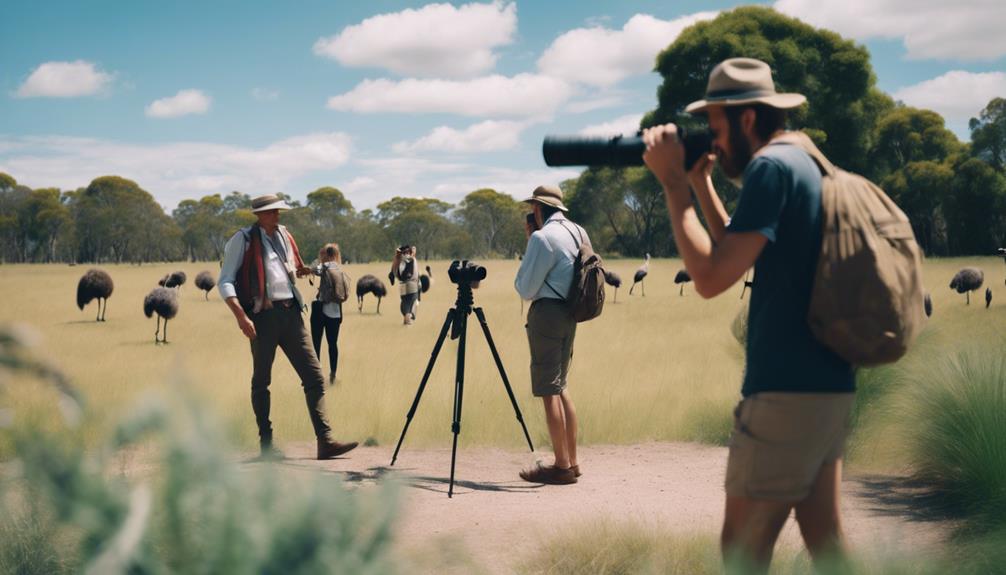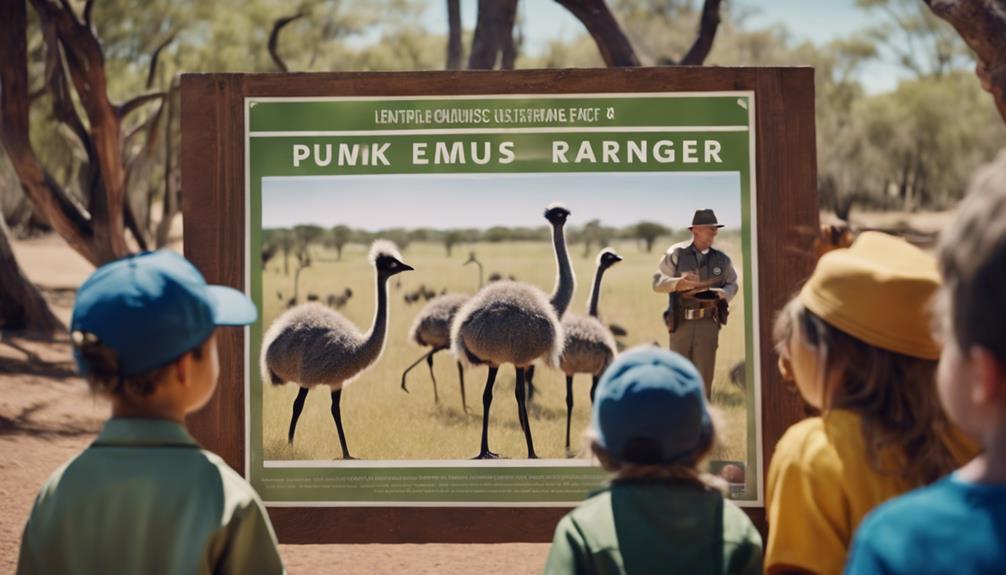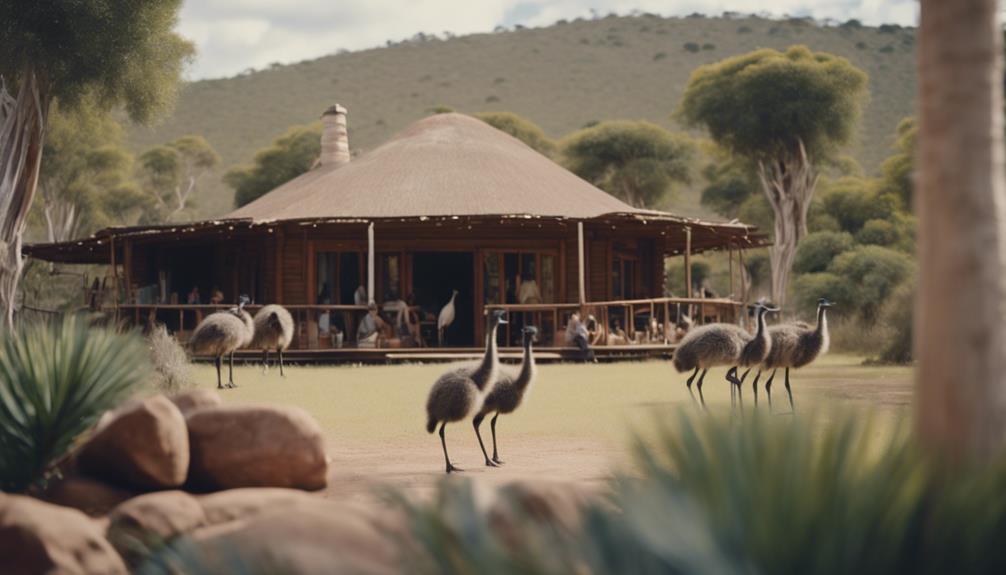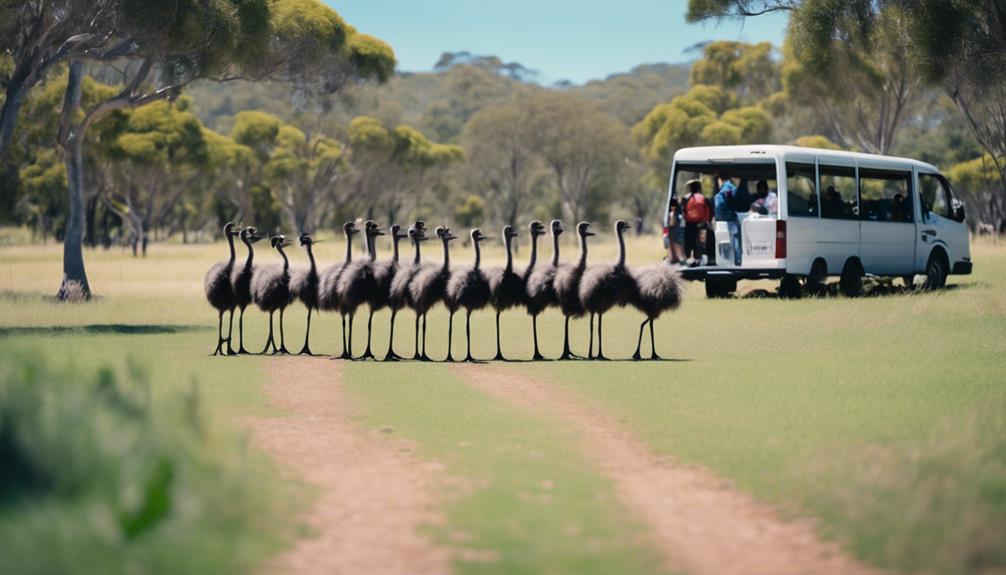
Imagine a world where emus roam freely, their populations flourishing in harmony with their natural habitats. By embracing eco-tourism as a tool for conservation, you can play a vital role in safeguarding these unique and fascinating creatures.
But how can a simple visit to an emu habitat make a difference? Stay tuned to uncover the untold benefits of eco-tourism in promoting emu conservation and discover the ripple effect of your actions on the future of these majestic birds.
Key Takeaways
- Eco-tourism raises awareness and funds for Emu conservation efforts.
- Engaging with tourists educates on Emu importance and habitat preservation.
- Sustainable tourism practices minimize negative impacts on Emus and their environment.
- Guided tours and educational programs offer valuable insights into Emu conservation.
Importance of Emu Conservation

Highlighting the essential role that Emu conservation plays in maintaining biodiversity and ecosystem balance is crucial for sustainable environmental management.
Emus, as a keystone species, significantly impact their habitat by influencing vegetation structure and seed dispersal. Conservation efforts are vital to ensure the stability of the Emu population, which serves as an indicator of ecosystem health. By protecting Emus, we can indirectly safeguard other species that share their habitat, contributing to overall biodiversity.
The preservation of Emus also aids in controlling insect populations, as these birds are known to consume large quantities of insects daily. Moreover, Emus play a role in seed dispersal, promoting plant diversity and regeneration.
Through targeted conservation strategies, such as habitat preservation and minimizing human-wildlife conflicts, we can secure the future of Emus and the ecosystems they inhabit. By focusing on Emu conservation, we aren't only preserving a unique and iconic species but also nurturing the intricate web of life that relies on their presence.
Eco-Tourism Benefits for Emus
Emus benefit from eco-tourism initiatives through increased public awareness and financial support for conservation efforts. By engaging with tourists, these majestic birds gain recognition, leading to enhanced protection measures and habitat preservation. Furthermore, the economic boost from eco-tourism aids in research projects focused on understanding emu behavior and their ecological impact.
| Emu Behavior | Ecological Impact |
|---|---|
| Social creatures | Seed dispersers |
| Nomadic lifestyle | Ecosystem engineers |
| Mating rituals | Biodiversity |
| Parental care | Habitat maintenance |
Emus, known for their social nature and nomadic lifestyle, play a crucial role in seed dispersal and act as ecosystem engineers by shaping vegetation through their foraging habits. Understanding their mating rituals and parental care contributes to biodiversity conservation. Moreover, the upkeep of their habitats ensures the maintenance of diverse ecosystems. Through eco-tourism, these aspects of emu biology become appreciated, fostering a deeper connection between people and wildlife for the betterment of conservation efforts.
Sustainable Practices for Tourists

Implementing sustainable practices as a tourist visiting emu habitats is crucial for minimizing negative impacts on the ecosystem and supporting long-term conservation efforts. To ensure your visit contributes positively to emu conservation, consider the following recommendations:
- Opt for Green Transportation: Choose eco-friendly transportation options such as public buses, bicycles, or electric vehicles when traveling to and within emu habitats to reduce carbon emissions.
- Stay in Sustainable Accommodations: Select eco-conscious lodging that implements energy-saving practices, waste reduction strategies, and supports local conservation initiatives to lessen your environmental footprint.
- Engage in Wildlife Photography: Capture the beauty of emus and their habitat responsibly by maintaining a safe distance, avoiding disturbance, and refraining from using artificial baits or calls.
- Embrace Bird Watching Opportunities: Take advantage of guided bird watching tours to learn about emus and other wildlife from knowledgeable experts while minimizing your impact on the natural environment.
Guided Tours for Awareness
To deepen your understanding of emu conservation and contribute to local preservation efforts, consider participating in guided tours that offer valuable insights into the importance of ecosystem protection and wildlife conservation. Emu behavior is a fascinating subject to observe during these tours. You may witness their intricate mating dances, distinctive vocalizations, and unique feeding habits, all of which play a crucial role in their survival within their natural habitat. These experiences not only provide you with a deeper appreciation for these majestic birds but also highlight the importance of conservation efforts to protect their species.
Guided tours focusing on conservation efforts allow you to witness firsthand the challenges faced by emus in the wild. By observing their interactions with the environment and learning about the threats they encounter, you gain a greater understanding of why conservation initiatives are essential. These tours also emphasize the interconnectedness of ecosystems and the significant impact that human activities can have on wildlife populations. Through this intimate exploration of emu behavior and conservation efforts, you can actively contribute to the preservation of these iconic birds and their habitats.
Educational Programs on Emus

Enhancing awareness through engaging educational programs fosters a deeper understanding of the intricate dynamics of emu behavior and conservation efforts. To achieve this, interactive workshops and hands-on experiences are essential components in educating the public about emus.
- Interactive Workshops: Emu educational programs often include interactive workshops where participants can learn about emu anatomy, behavior, and habitat in a hands-on setting.
- Hands-On Experiences: Providing hands-on experiences such as feeding emus or observing them in their natural habitat allows participants to connect with these unique birds on a more personal level.
- Expert Guidance: Having knowledgeable guides lead educational programs ensures that participants receive accurate information and can ask questions to deepen their understanding of emus and their conservation needs.
- Demonstrations: Live demonstrations showcasing emu behaviors, such as mating dances or nest-building, offer a firsthand look at these fascinating creatures in action, further enhancing the educational experience.
Community Involvement in Conservation
Community involvement plays a crucial role in the conservation efforts aimed at protecting emus and their habitats. Community engagement is vital for the success of conservation initiatives as it fosters a sense of ownership and responsibility among local residents. By actively involving the community in conservation projects, such as habitat restoration and wildlife monitoring programs, a more sustainable and effective approach to emu preservation can be achieved.
Through community engagement, individuals become stewards of their environment, gaining a deeper understanding of the importance of emus in the ecosystem. This heightened awareness often leads to increased participation in conservation initiatives, such as volunteering for habitat clean-ups or supporting eco-friendly practices in their daily lives. When communities are actively involved in conservation efforts, the impact isn't only localized but also has the potential to create ripple effects, inspiring others to take part in similar initiatives.
Economic Impact of Eco-Tourism

Engaging in eco-tourism can have significant economic impacts on local communities near emu habitats. When tourists visit these areas to observe emus in their natural habitat, it generates tourism revenue, which can be reinvested in conservation efforts. Furthermore, eco-tourism plays a vital role in providing conservation funding, as a portion of the proceeds often goes directly into conservation programs to protect emu populations.
Four key economic impacts of eco-tourism near emu habitats are:
- Tourism Revenue: Eco-tourism activities such as guided tours, bird watching, and educational programs attract visitors who contribute to the local economy through accommodation, food, and other services.
- Conservation Funding: Revenues generated from eco-tourism can be allocated to fund research projects, habitat restoration, and anti-poaching efforts, directly supporting emu conservation.
- Job Creation: The growth of eco-tourism near emu habitats creates employment opportunities for local residents, ranging from tour guides and hospitality staff to conservation experts and researchers.
- Community Development: Eco-tourism fosters community development by improving infrastructure, services, and overall quality of life for residents living near emu habitats.
Conservation Challenges and Solutions
Tourists' increasing presence near emu habitats for eco-tourism activities has brought to light various challenges facing the conservation efforts for these unique birds, necessitating innovative solutions to ensure their long-term survival. Conservation partnerships play a crucial role in pooling resources and expertise to address these challenges effectively. Collaborating with local communities, governmental agencies, and non-profit organizations can amplify conservation impact. Fundraising events also play a vital role in generating financial support for conservation projects, enabling the implementation of research initiatives and habitat restoration programs.
Research initiatives are essential for understanding emu behavior, habitat requirements, and threats they face. By conducting scientific studies on emu populations, researchers can provide valuable insights to guide conservation strategies. Habitat restoration is another key aspect of emu conservation. Rehabilitating degraded habitats, planting native vegetation, and implementing sustainable land management practices are essential to ensure the long-term survival of emus in the wild. By addressing these challenges through innovative solutions, we can safeguard the future of emus and their ecosystems.
Emu Habitats and Biodiversity

Emu habitats are characterized by diverse ecosystems that support a rich biodiversity of plant and animal species, contributing significantly to the overall ecological balance of their environments.
- Biodiversity Hotspots: Emu habitats are considered biodiversity hotspots due to the wide array of species they support, ranging from insects to large mammals. This high biodiversity contributes to the resilience and sustainability of these ecosystems.
- Emu Population Dynamics: Understanding emu population dynamics is crucial for effective conservation efforts. Factors such as habitat loss, climate change, and human interference play a significant role in shaping emu populations.
- Habitat Restoration: Initiatives focusing on habitat restoration are essential for maintaining the balance of emu habitats. Restoring degraded areas, planting native vegetation, and creating corridors for emu movement are vital steps in ensuring their survival.
- Conservation Efforts: Conservation efforts aimed at protecting emu habitats are critical. Through eco-tourism, raising awareness, and implementing sustainable practices, we can safeguard these unique ecosystems for future generations.
Role of Local Guides in Conservation
Local guides play a pivotal role in facilitating conservation efforts within emu habitats by providing valuable insights, guidance, and support to visitors. Through local engagement, these guides create a bridge between tourists and the conservation strategies necessary to protect emus and their habitats. By sharing their knowledge of the local environment, including the behavior and habitat of emus, guides enhance visitors' understanding and appreciation of these unique birds. This understanding often leads to increased respect for the ecosystem and a desire to actively participate in conservation efforts.
Guides also play a crucial role in promoting responsible behavior among tourists, ensuring that visitors adhere to conservation guidelines and minimize their impact on the environment. By leading by example and emphasizing the importance of sustainable practices, guides help instill a conservation-minded mindset in visitors. This hands-on approach not only benefits the emus and their habitats but also fosters a sense of stewardship and responsibility among tourists, encouraging them to become advocates for conservation both locally and globally.
Promoting Responsible Tourism

To promote responsible tourism within emu habitats, visitors are encouraged to adhere to conservation guidelines and minimize their environmental impact. When engaging in wildlife encounters, ethical practices should always be prioritized to ensure the well-being of the emus and their natural habitats.
Here are four essential ways you can contribute to the conservation efforts while enjoying your eco-tourism experience:
- Stay on Designated Paths: By sticking to marked trails, you help prevent habitat destruction and disturbance to emus and other wildlife species.
- Respect Wildlife: Keep a safe distance from emus and observe them without causing stress or interference in their natural behaviors.
- Dispose of Waste Properly: Carry out all trash from the habitats to maintain the cleanliness and integrity of the environment.
- Support Local Conservation Initiatives: Contribute to local conservation projects or organizations dedicated to protecting emus and their habitats for future generations to enjoy.
Long-Term Impact on Emu Population
Promoting responsible eco-tourism practices within emu habitats plays a critical role in assessing and mitigating the long-term impact on the emu population. Impact assessment is essential to understand how eco-tourism activities influence emu behavior, reproduction, and overall population dynamics. By implementing rigorous population monitoring protocols, researchers can track changes in emu numbers, distribution, and health over time. These monitoring efforts provide valuable data for conservationists to evaluate the effectiveness of eco-tourism initiatives in safeguarding the emu population.
Long-term impact assessment allows us to identify potential threats to emus, such as habitat disturbance, increased human interactions, or changes in food availability. By continuously monitoring the emu population, scientists can detect any concerning trends early on and take proactive measures to address them. Through collaborative efforts between researchers, conservationists, and tour operators, we can ensure that eco-tourism remains a sustainable practice that benefits both emus and the local community. By prioritizing the long-term well-being of emu populations, we can foster a harmonious coexistence between humans and these iconic Australian birds.
Frequently Asked Questions
How Do Emus Contribute to the Ecosystem Beyond Their Conservation Importance?
Emus play a vital role in the ecosystem beyond conservation by influencing plant growth through seed dispersal, altering vegetation structure, and providing habitat and food for various species. Their behavior has a significant impact on biodiversity.
Are There Any Traditional Practices or Cultural Beliefs Related to Emus That Are Being Integrated Into the Eco-Tourism Programs?
As you explore the integration of traditional practices and cultural beliefs into eco-tourism programs, consider the enriching experiences that can arise. Community involvement in conservation initiatives can foster a deep connection, transcending age restrictions.
How Do Tourists Contribute to the Preservation of Emu Habitats During Their Visits?
During visits, you contribute to emu habitat preservation by engaging in eco-friendly practices, supporting local conservation efforts, and learning about sustainable tourism. Your involvement aids in protecting emu habitats and promoting community-based conservation initiatives.
Are There Any Specific Age Restrictions or Requirements for Participating in the Guided Tours Focused on Emu Awareness?
You might think there are age restrictions or strict tour requirements for emu-focused guided tours, but surprise! These tours are open to all ages and no prior knowledge is needed. Embrace the emu education!
What Are Some of the Lesser-Known Threats to Emu Conservation That Are Being Addressed Through Community Involvement Initiatives?
Lesser-known threats to emu conservation, addressed through community engagement initiatives, include habitat loss due to agricultural expansion and feral predators like foxes. Conservation partnerships aim to mitigate these risks and secure a sustainable future for emus.
Conclusion
In conclusion, by engaging in eco-tourism activities focused on emu conservation, you can contribute to the preservation of this iconic species. Your participation in guided tours, educational programs, and sustainable practices can have a significant impact on emu habitats and biodiversity.
By promoting responsible tourism, you're helping ensure the long-term survival of emus in their natural environment. Embrace this opportunity to be a steward of emu conservation and make a lasting difference for future generations.




